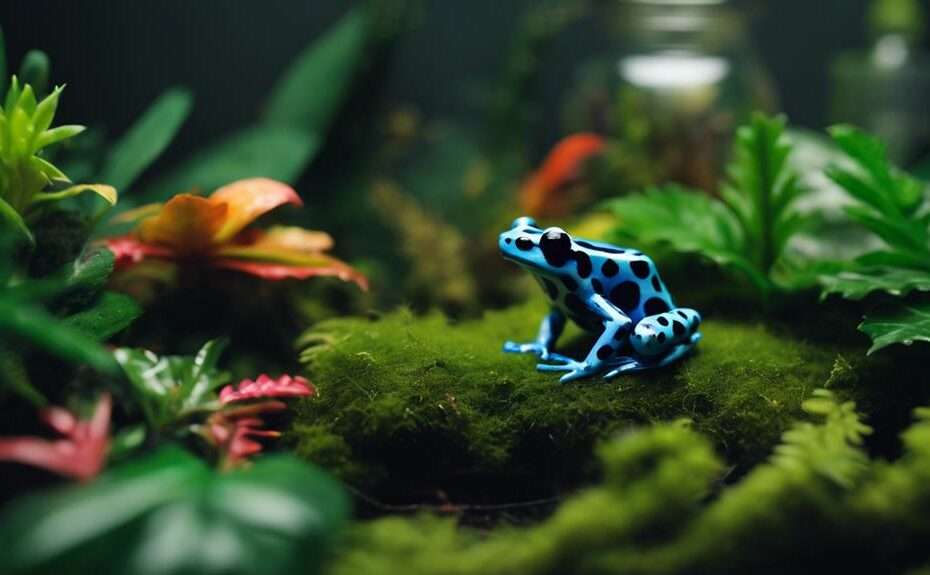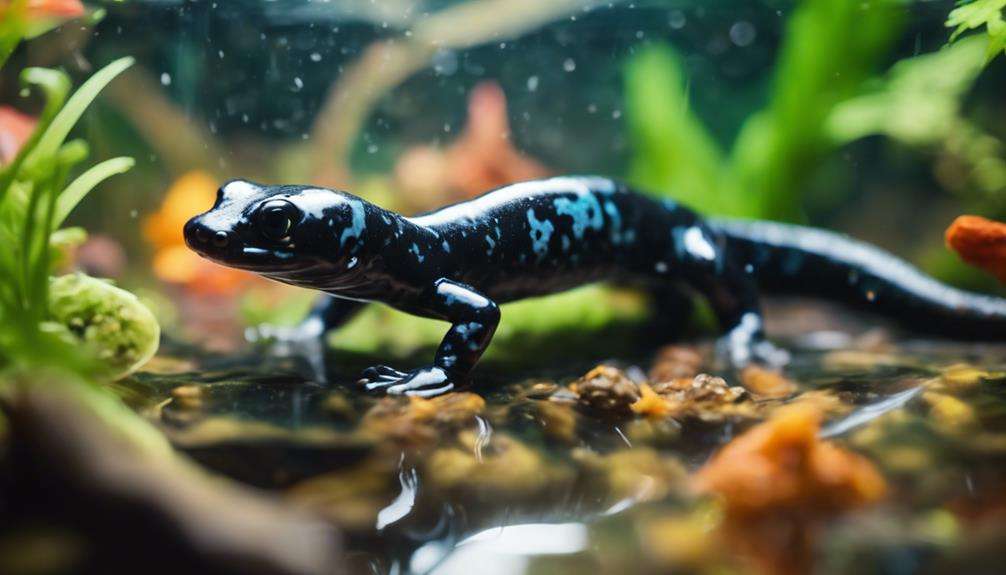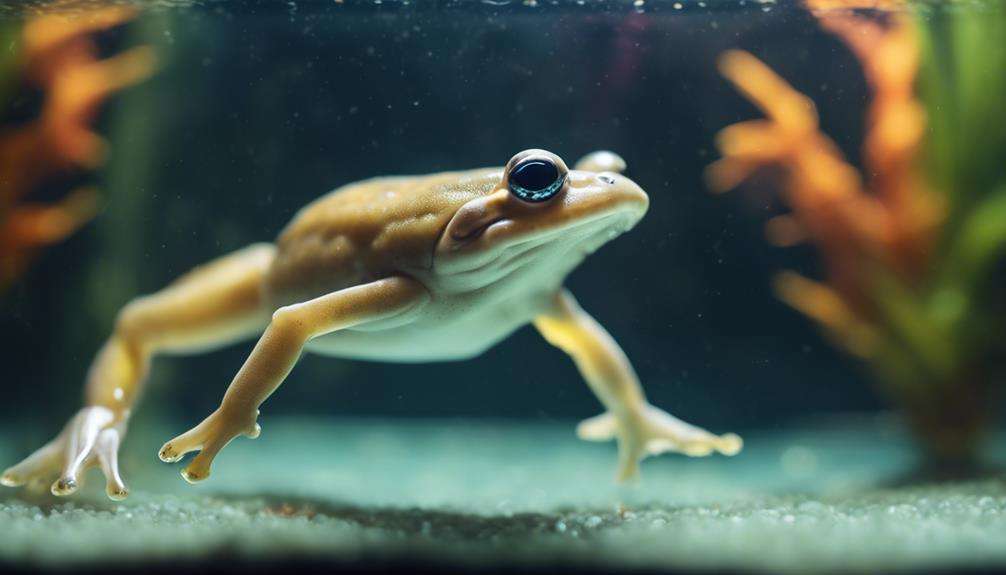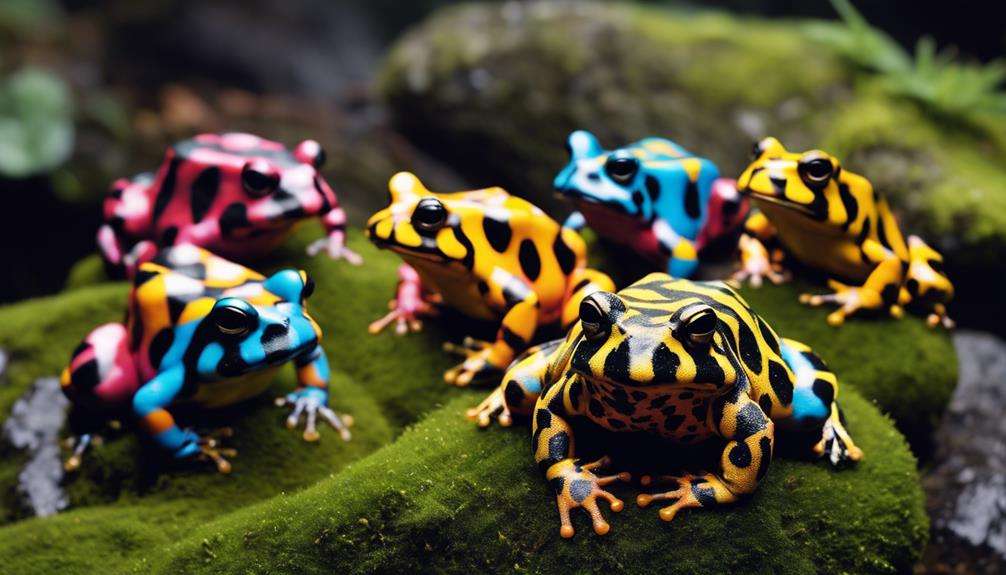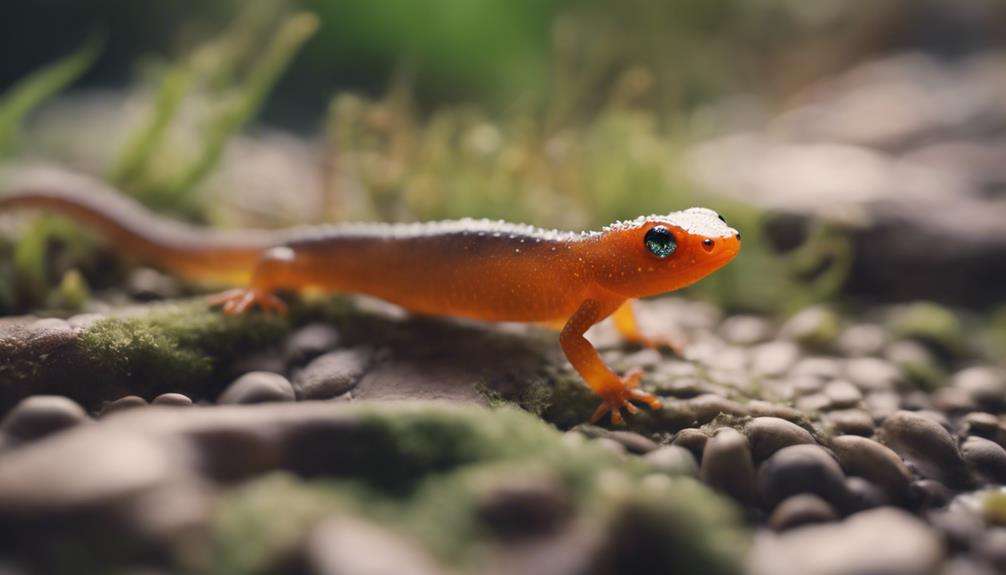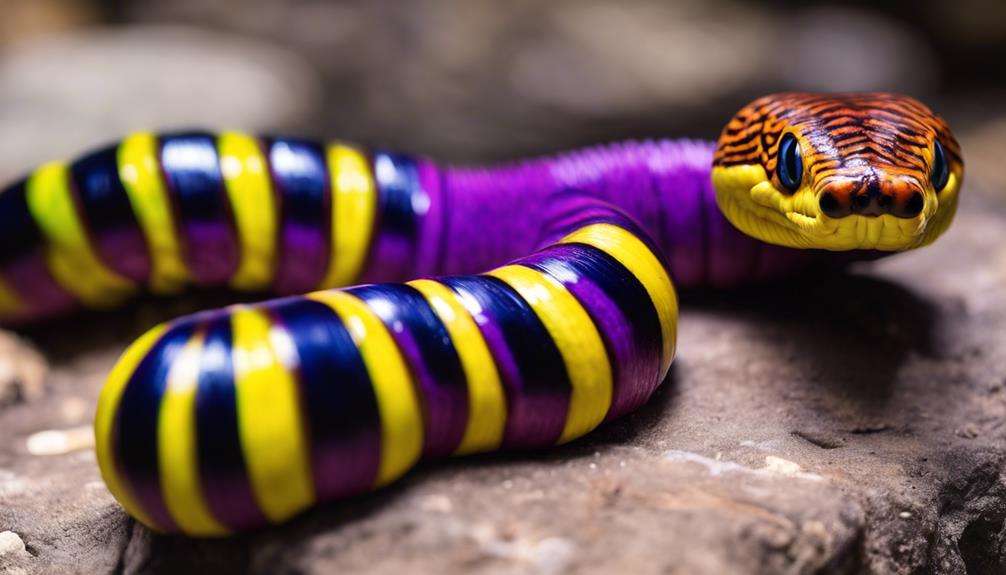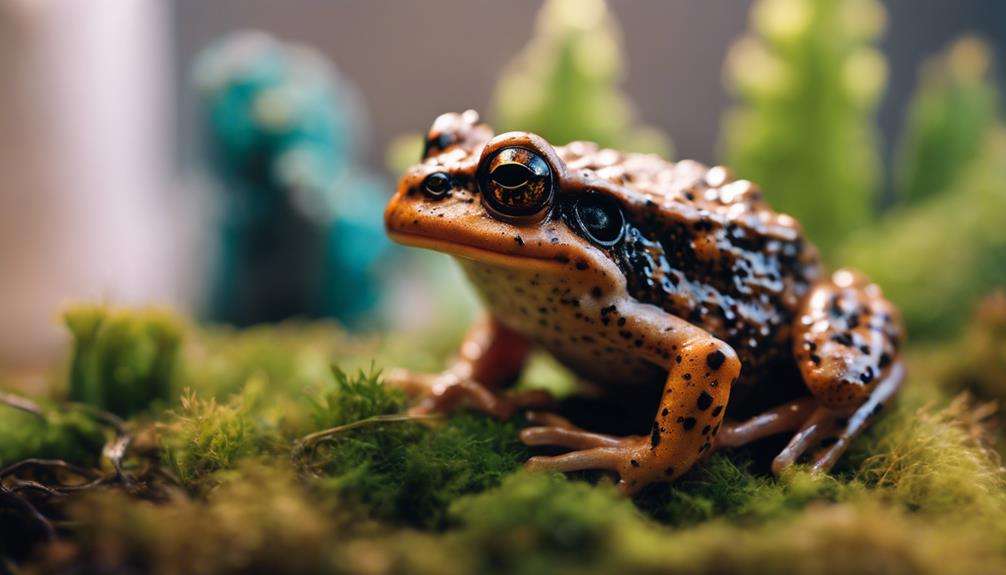When it comes to dart frogs, selecting the right species is akin to choosing gems from a dazzling mosaic. The world of dart frogs offers an array of captivating choices, each with its allure and appeal.
As a collector, navigating through this kaleidoscope of colors and patterns can be both exciting and daunting. However, understanding the nuances of each species and discovering the hidden gems can truly elevate your collection to new heights.
So, which dart frogs will make the cut for your collection? Explore further to uncover the top picks that will leave you mesmerized and eager to enhance your collection.
Key Takeaways
- Blue Poison Dart Frog and Splash-Back Dart Frog are ideal for beginner collectors.
- Distinctive features like vibrant yellow markings of Dendrobates leucomelas attract enthusiasts.
- Azureus Dart Frogs with varying shades of blue offer color appreciation opportunities.
- Proper terrarium setup and care are crucial for maintaining toxic Dart Frog species.
Blue Poison Dart Frog
The Blue Poison Dart Frog, scientifically known as Dendrobates tinctorius azureus, captivates collectors with its stunning azure hue and robust size. Originating from Suriname, these thumbnail frogs are a sought-after species among dart frog enthusiasts. Measuring up to 2 inches, D. tinctorius azureus stands out for its larger size compared to other dart frog varieties.
In terrariums, these Blue Poison Dart Frogs exhibit a bold and active demeanor, making them a delight to observe. Their striking blue coloration adds vibrancy to any collection, drawing attention with their eye-catching appearance. Despite their vivid hue, these frogs aren't just for show; they're also a great choice for beginner frog keepers due to their hardy nature.
When considering dart frog species for your collection, the Blue Poison Dart Frog is a top contender, blending beauty with ease of care. Whether you're a seasoned collector or just starting out, Dendrobates tinctorius azureus is sure to bring a pop of color and liveliness to your terrarium setup.
Splash-Back Dart Frog
With its striking orange and black coloration, the Splash-Back Dart Frog, scientifically known as Dendrobates galactonotus, stands out as a vibrant species native to the Amazon rainforest. These dart frogs are highly sought after by collectors for their colorful appearance that mimics the warning signals of toxicity found in nature. Their small size makes them well-suited for terrarium setups, where enthusiasts can create a naturalistic environment to observe these fascinating creatures up close.
When setting up a terrarium for Splash-Back Dart Frogs, it's crucial to mimic their natural habitat. Providing ample hiding spots, such as leaf litter and small branches, allows these shy frogs to feel secure. Maintaining high humidity levels and a consistent temperature range is essential for their well-being. These frogs are relatively easy to care for, but attention to detail is necessary to ensure they thrive in captivity.
Observing the behaviors of Splash-Back Dart Frogs in a well-designed terrarium setup can offer insights into their natural behaviors and add a touch of the Amazon rainforest to your living space.
Black Jungle Frog
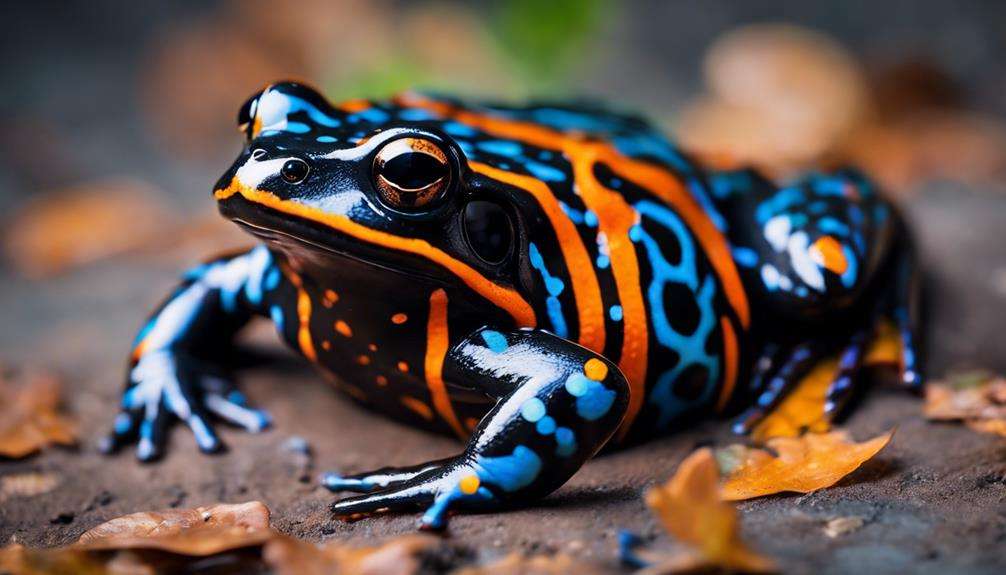
The Black Jungle Frog, scientifically known as Dendrobates leucomelas, showcases a distinctive color combination of bold black and vibrant yellow, making it a standout species among dart frogs.
When caring for these frogs, it's crucial to replicate their natural habitat, providing ample hiding spots, humidity levels, and a diet rich in insects.
Understanding the unique color patterns, habitat preferences, and care requirements of the Black Jungle Frog is essential for enthusiasts looking to add this striking species to their dart frog collection.
Unique Color Patterns
Exhibiting a striking color pattern of black and yellow, the Black Jungle Frog, specifically Dendrobates leucomelas, captivates collectors with its bold and visually appealing appearance. This unique coloration sets it apart from other dart frog species and adds vibrancy to any collection.
Here are some key points to note about the Black Jungle Frog's color patterns:
- The contrast between the black body and vibrant yellow markings creates a visually stunning appearance.
- The distinct color pattern serves as a warning to predators, indicating the frog's toxicity.
- Dendrobates leucomelas, also known as the Bumblebee Dart Frog, is highly sought after by collectors for its striking and unique coloration.
These features make the Black Jungle Frog a standout choice for enthusiasts looking to add diversity to their dart frog collections.
Habitat and Care Requirements
Originating from Central America, the Black Jungle Frog, also known as Dendrobates auratus, thrives in tropical rainforest habitats characterized by high humidity levels and abundant vegetation. When setting up their terrarium, ensure live plants for cover, climbing areas, and a shallow water dish.
Select plants like bromeliads and pothos to mimic their natural environment. Feed Black Jungle Frogs small insects such as fruit flies, ensuring a varied diet rich in calcium and other essential nutrients.
Maintaining temperatures between 72-80°F and humidity levels around 80% is vital. Use a hygrometer to monitor humidity and mist the enclosure regularly. Providing a well-balanced habitat and meeting their dietary and environmental needs will contribute to the overall health of your Black Jungle Frog.
Strawberry Poison Dart Frog
With vibrant red coloration and striking blue legs, the Strawberry Poison Dart Frog, scientifically known as Oophaga pumilio, is a captivating species native to the lush rainforests of Central America. This small to medium-sized frog is a popular choice among collectors for its stunning appearance and interesting behaviors.
- Breeding habits: The Strawberry Poison Dart Frog exhibits unique breeding habits, with males being responsible for carrying tadpoles on their backs to water sources. This parental care behavior is crucial for the survival of the offspring.
- Color variations: While the species is predominantly recognized for its bright red coloration with blue legs, there are variations in color patterns within different populations. Some individuals may display variations in the intensity of red hues or the presence of black markings.
- Conservation status: Due to habitat loss and collection for the pet trade, the conservation status of the Strawberry Poison Dart Frog is of concern. Conservation efforts in their native habitats of Costa Rica and Panama are vital to ensure the survival of this captivating species.
Green and Black Dart Frog
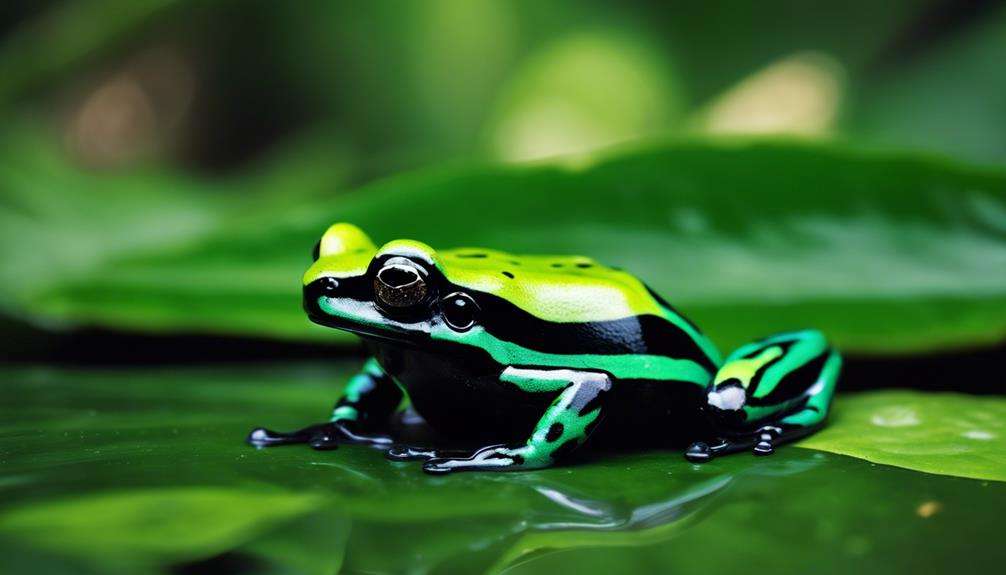
The Green and Black Dart Frog, scientifically known as Dendrobates auratus, captivates collectors with its vibrant green coloration and intricate black patterns, making it a visually stunning choice for enthusiasts. These medium-sized dart frogs exhibit fascinating breeding behavior, with males often calling to attract females and engaging in elaborate courtship rituals. Dendrobates auratus also showcases various color morphs within its species, ranging from bright lime green to deep forest green, adding to the allure for collectors seeking diversity in their dart frog collection.
In terms of feeding habits, these frogs are insectivores, primarily consuming small invertebrates like fruit flies, springtails, and pinhead crickets. Providing a varied diet is essential for their health and vitality. When setting up a terrarium for the Green and Black Dart Frog, it's crucial to mimic their natural habitat, including ample plants for hiding spots and climbing opportunities. This species thrives in well-maintained terrarium environments with appropriate humidity levels and temperature gradients, making them a rewarding choice for experienced collectors looking to observe their active behavior up close.
Azureus Dart Frog
Dendrobates tinctorius azureus, the striking blue Azureus Dart Frog from Suriname, presents collectors with a visually captivating addition to their dart frog collections. These frogs boast a vibrant blue coloration with intricate black markings, making them highly desired by enthusiasts.
When caring for Azureus Dart Frogs, consider the following:
- Breeding Habits: Azureus Dart Frogs typically breed in small pools of water, laying their eggs on leaves above the water. The male frog will then fertilize the eggs, and tadpoles will hatch and develop in the water until they metamorphose into adult frogs.
- Terrarium Setup: Provide a humid environment with plenty of live plants for hiding spots. Ensure proper ventilation to prevent mold growth and maintain a consistent temperature of around 74-78°F (23-26°C).
- Color Variations: While Azureus Dart Frogs are known for their striking blue coloration, variations in shades of blue may exist among individuals due to genetic factors or environmental influences. Pay attention to these nuances to appreciate the beauty of these frogs in your collection.
Dyeing Poison Frog
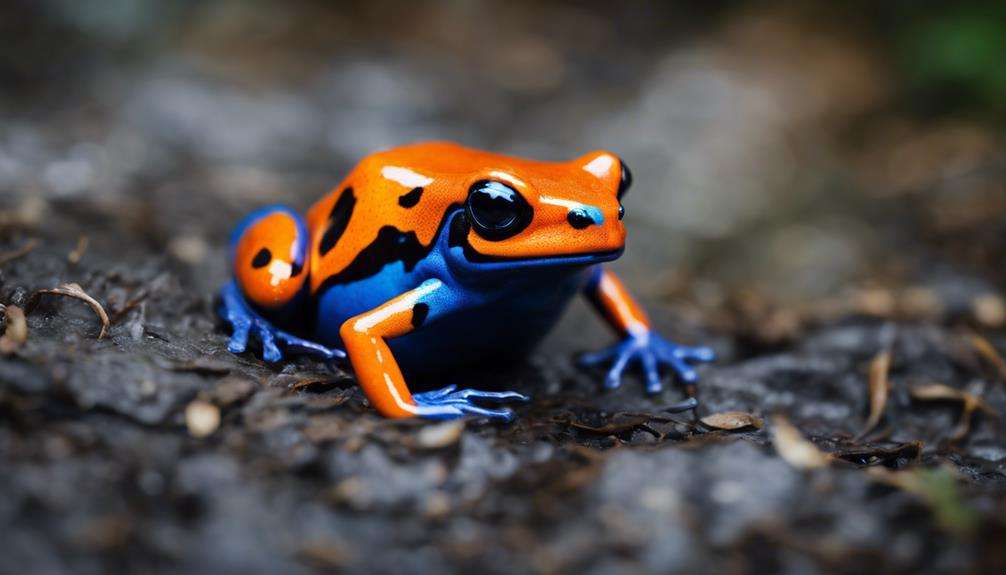
Visually striking with vibrant colors like blue, black, and yellow, the Dyeing Poison Frog, a species highly sought after by collectors, captivates enthusiasts with its bold and active nature. Dendrobates tinctorius, the scientific name for this dart frog, impresses with its large size, typically ranging from 1.5 to 2 inches in length. When housing these frogs, a terrarium setup with high humidity levels is essential to mimic their natural habitat. In terms of diet, Dyeing Poison Frogs primarily feed on small insects like fruit flies and pinhead crickets.
Breeding behavior of Dendrobates tinctorius involves the male frog calling to attract a female for mating. Once the female lays eggs, the male protects them until they hatch into tadpoles. When handling these frogs, it's crucial to take precautions as they produce toxins through their skin. While the toxicity levels vary among individual frogs, it's advisable to avoid direct contact and always wash hands after any interaction with them.
Phantasmal Poison Frog
Captivating collectors with its vibrant coloration and small size, the Phantasmal Poison Frog, scientifically named Epipedobates tricolor, hails from Ecuador and boasts a striking combination of black, blue, and red hues on its body. This species of dart frog is highly sought after for its unique characteristics.
When considering the Phantasmal Poison Frog for your collection, here are some key points to note:
- Toxicity Levels: The Phantasmal Poison Frog is known for its toxic skin secretions, which are a defense mechanism against predators. When handling these frogs, caution must be exercised to avoid any contact with the skin.
- Breeding Behavior: In captivity, these frogs can be bred successfully with proper care and attention to their environmental needs. Breeding pairs should be monitored closely to ensure successful reproduction.
- Color Variations: While the classic color combination of black, blue, and red is most commonly seen in the Phantasmal Poison Frog, there can be slight variations in the intensity and distribution of these colors among individual frogs. These variations add to the allure of this stunning species.
Yellow-Banded Poison Dart Frog
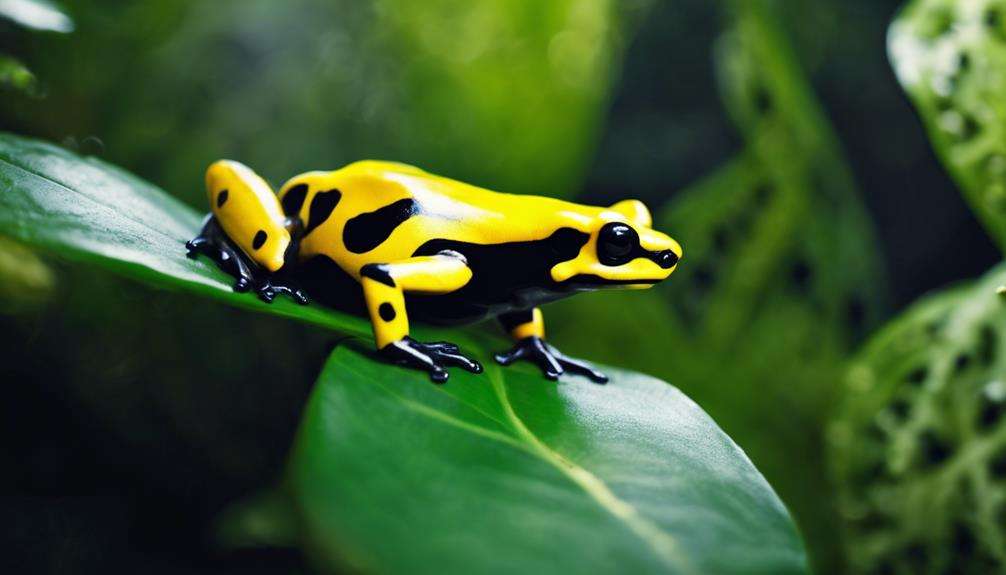
The vibrant Yellow-Banded Poison Dart Frog, known scientifically as Dendrobates leucomelas, is highly prized among collectors for its striking yellow and black banded coloration. When it comes to breeding habits, these frogs are known to lay their eggs in moist environments, such as leaf litter or on plants near water sources. The male frog diligently cares for the eggs until they hatch, showcasing strong parental instincts.
In terms of feeding preferences, Dendrobates leucomelas are insectivores, known to consume a variety of small invertebrates like fruit flies, ants, termites, and springtails. Their active nature and hunting skills make feeding sessions an intriguing spectacle for observers.
Behaviorally, these frogs are bold and confident, often displaying territorial behaviors. They're also diurnal, meaning they're most active during the day. Their distinct bumblebee-like appearance serves as a warning to potential predators about their toxicity, contributing to their survival in the wild. These characteristics, coupled with their striking coloration, make the Yellow-Banded Poison Dart Frog a captivating addition to any dart frog enthusiast's collection.
Frequently Asked Questions
What Is the Best Dart Frog to Own?
For the most colorful dart frog, consider the Ranitomeya imitator Varadero. This smallest species boasts vibrant orange and blue legs. Breeding tips include providing ample hides and nutritious food. They are prolific breeders among thumbnail frogs.
What Is the Best Looking Dart Frog?
When it comes to the best-looking dart frog, the vibrant colors and unique patterns of Ranitomeya imitator Varadero are truly captivating. Their striking appearances and eye-catching designs make them a top choice for any collector.
What Are the Most Rare Dart Frogs?
Rare dart frogs, like Pippa debattei and Felony high santa isabela, pose breeding challenges due to limited availability. Conservation efforts are crucial to protect these species. Seek specialized breeders or auctions to acquire these prized frogs for your collection.
What Is the Most Popular Poison Dart Frog?
When it comes to poison dart frogs, the most popular choice is the Phyllobates terribilis. Its vibrant color morphs and potent toxins have captivated collectors worldwide. Conservation efforts and breeding programs aim to protect this species.
Conclusion
You've delved into the world of dart frog collecting, discovering the vibrant beauty and unique characteristics of top picks like the Blue Poison Dart Frog and Strawberry Poison Dart Frog.
With careful research and guidance from experienced collectors, you've embarked on a journey to select the perfect addition to your collection.
Embrace the allure of these captivating creatures as you continue to explore the fascinating world of dart frogs.
